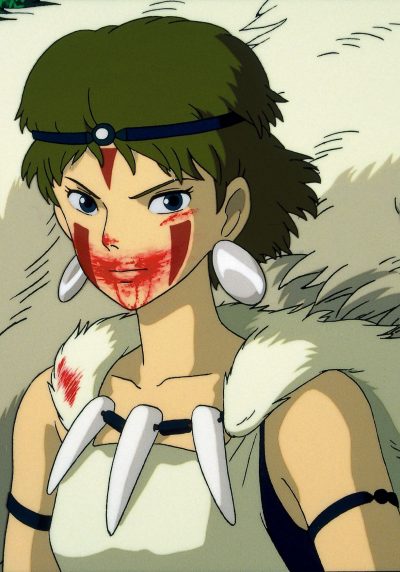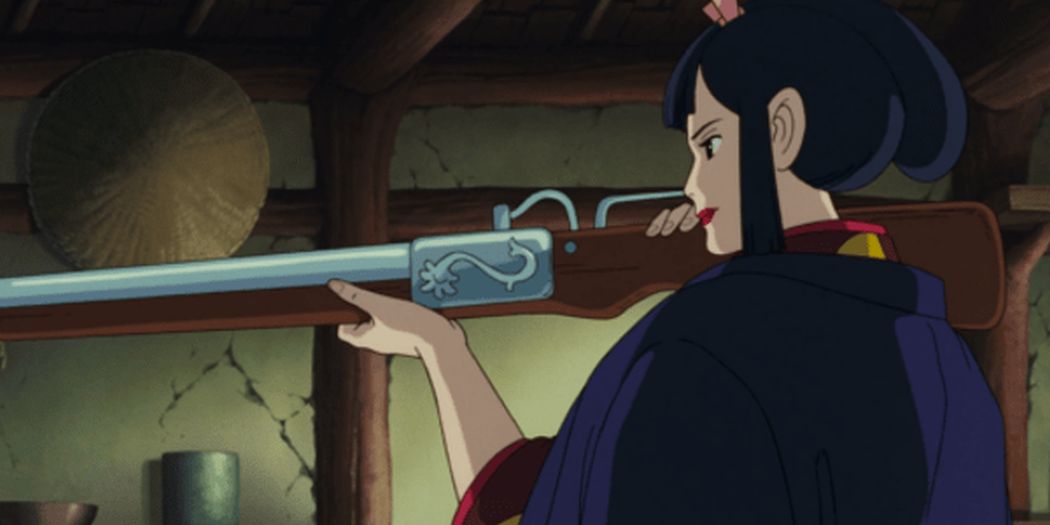★★★½
“Princess Die”
 To some extent, this was the film which “broke” Miyazaki in the West, being his first feature to receive an unedited theatrical release in America. It wasn’t a huge commercial success, taking only about $2.4 million in North America. But it was very well-received, Roger Ebert listing it among his top ten films of 1999. It likely opened the door for the success of Spirited Away, which would win Miyazaki the Oscar for Best Animated Feature at the 75th Academy Awards. But if I’m being honest, I don’t like it as much as many of his movies. While there’s no denying the imagination and enormous technical skill here, it doesn’t resonate emotionally with me in the same way. I think it’s probably the central character, who is relatively bland and uninteresting, even compared to other characters in the movie.
To some extent, this was the film which “broke” Miyazaki in the West, being his first feature to receive an unedited theatrical release in America. It wasn’t a huge commercial success, taking only about $2.4 million in North America. But it was very well-received, Roger Ebert listing it among his top ten films of 1999. It likely opened the door for the success of Spirited Away, which would win Miyazaki the Oscar for Best Animated Feature at the 75th Academy Awards. But if I’m being honest, I don’t like it as much as many of his movies. While there’s no denying the imagination and enormous technical skill here, it doesn’t resonate emotionally with me in the same way. I think it’s probably the central character, who is relatively bland and uninteresting, even compared to other characters in the movie.
Firstly though: no, there’s no-one called “Mononoke” in this. It’s not a name, but a Japanese term describing a supernatural shape-shifting creature. Though even this seems ripe to cause confusion, because there are no shape-shifting princesses to be found either. And despite the title, the protagonist is Ashitaka (Matsuda), a prince of the Emishi tribe in medieval Japan, whose arm becomes infected after an encounter with a demon-possessed wild boar. As happens… Seeking a cure before the rest of his body follows suite, despite the superhuman strength it gives him, Ashitaka heads into the Western lands, and straight into the middle of an ongoing battle.
On one side is Lady Eboshi (Tanaka), the ruler of Irontown, a progressive and industrial settlement, in need of the resources which can be found in and under the nearby forest. On the other is San (Ishida), a young woman raised by wolves, who has vowed to protect the woods and their inhabitants, including the Great Forest Spirit. It’s their conflict which is really the core of the film, with Ashitaka’s quest to get his demonic arm fixed, taking a back-seat for most of the (lengthy, at 133 minutes) running-time here. Probably for the best, since he is, as mentioned, perhaps the least charismatic or engaging protagonist in the entire Miyazaki canon. His arm is easily the most interesting thing about him – and that keeps wanting to strike out on its own. When your own limb wants to go solo, you might be the problem… To quote Lady Eboshi, “I’m getting a little bored of this curse of yours, Ashitaka. Let me just cut the damn thing off.” #ImWithTeamEboshi
But enough of him. Let’s focus on what works here, which would be San and Eboshi. The first time we see San, her face is smeared in blood which she has sucked up and spat out, from a wound in the side of a gigantic white wolf. [This is certainly the most hardcore of Miyazaki’s films, with decapitations and limbs being lost at a rate closer to an entry in the Lone Wolf & Cub franchise.] She’s relentlessly aggressive in attitude, going so far as to stage a one-woman assault on Irontown in an attempt to assassinate her enemy. She tells Ashitaka, “I’m not afraid to die. I’d do anything to get you humans out of my forest.” That said, she’s still considerably less creepy than the forest apes who want to eat him.
Eboshi, on the other hand, is a complete contrast to the near-feral San, and remarkably progressive, especially considering the era and location. Her town is a haven for the disenfranchised and those society considers “untouchables”, including both lepers and prostitutes, the latter whose contracts she bought out and who now work in her iron mill. Her citizens and their welfare are what she cares about, above all, and she’s completely fearless about who she has to go through for that purpose. “She’s not even afraid of the gods, that woman,” says one of Irontown’s residents about their ruler, admiringly. They aren’t wrong, for she subsquently tells her warriors, “I’m going to show you how to kill a god, a god of life and death. The trick is not to fear him.” It’s remarkably easy to envisage a version where the roles are reversed, and she is the heroine. The fact she’s a gun enthusiast, is just a bonus!

Ashitaka’s role is largely to act as a middleman between the two worlds: somewhat more than human, yet less than divine. That remains the case even at the end, as he agrees to spent part of his time in the forest with San, and part of it working alongside Lady Eboshi in Irontown. It’s potentially an awkward and unsatisfying compromise, storywise, yet Miyazaki makes it work better than you feel it should. But there are a couple of perplexing missteps too. For one, when the animals of the forest are talking, there’s zero effort to make their lips synch up. It’s bizarre and distracting. And in the Japanese version, the voice of San’s wolf mother, Moro is a man. Someone known in Japan as a drag queen, admittedly – but a man none the less, a weird choice which confused the heck out of me [score one for the dub, at least, which had Gillian Anderson as the character]
The overall result is undeniably beautifully animated, and epic in its scope and invention. As ever, Miyazaki excels at creating a world which is like our own, yet simultaneously completely alien. However, it all gets rather wearing, especially at the length depicted here. My attention simply ran dry during the second half, as the multiple different factions began hacking or gnawing away on each other, with the personal and intense quality of the Eboshi/San conflict getting lost in the bigger picture. It’s in putting over the intensely personal elements of large stories, that Miyazaki is unsurpassed – never mind just in animation, among film-makers as a whole. This isn’t the best demonstration of his talents in that area.
Dir: Hayao Miyazaki
Star: Yōji Matsuda, Yuriko Ishida, Yūko Tanaka, Kaoru Kobayashi




